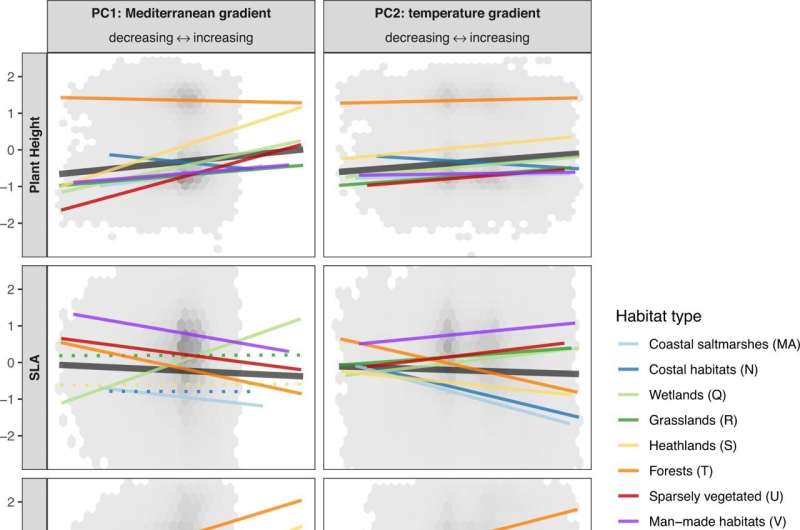This article has been reviewed according to Science X's editorial process and policies. Editors have highlighted the following attributes while ensuring the content's credibility:
fact-checked
peer-reviewed publication
proofread
Global climate data insufficiently explains composition of local plant species, say geobotanists

The global climate influences regional plant growth—but not to the same extent in all habitats. This finding was made by geobotanists at Martin Luther University Halle-Wittenberg (MLU) after analyzing more than 300,000 European vegetation plots. Their conclusion is that no general prediction can be made about the effects of climate change on the Earth's vegetation; instead, the effects depend to a large degree on local conditions and the habitat under investigation. Their findings were published in Nature Communications.
Ever since Alexander von Humboldt's voyages of exploration, it has been clear that the characteristics of plants depend heavily on the Earth's climate zones. For example, giant trees and plants with enormous leaves can be found in tropical rainforests, while desert or subarctic vegetation grows lower to the ground and has smaller leaves to withstand drought or cold temperatures.
Climate change is causing these zones to shift—raising questions as to how higher temperatures and altered periods of precipitation affect the composition of plant species at a given location. "Studies have found relatively weak correlations between global climate gradients and the characteristics of local plant communities," explains Dr. Stephan Kambach, a research associate in the Department of Geobotany at MLU. "It is possible that the global effects are being obscured by local factors such as plant composition, soil conditions, microclimate, groundwater levels or human land use."
To get to the heart of this phenomenon, the researchers from Halle have compiled more than 300,000 vegetation plots from all over Europe that contain complete information on the predominant plant species and climate data. This has been done as part of the Biodiversa program "FeedBaCks." The raw data were taken from the CHELSA climate database and the European Vegetation Archive (EVA), which includes more than 1.7 million vegetation plots of nearly 14,000 plant species.
"First, we examined nine main types of habitats, for example forests, moorlands or wetlands," explains Kambach. "Then we subdivided these habitats into two additional sub-levels, for example deciduous forests on the second level and poplar floodplain forests on the third level." In order to compare the vegetation in the different habitats, four key vegetation characteristics were defined: height of growth, leaf area, root length and seed mass.
Stephan Kambach used linear regression to investigate the influence of climate variables, especially temperature and precipitation, on vegetation. Linear regression is a statistical tool that can be used to describe major dependencies between influencing and target variables. The analysis revealed some surprising results: When all vegetation types are considered, climate is a significant predictor of plant characteristics. In the Mediterranean region or along Europe's coasts, plants grow taller on average, produce more seed mass and have longer roots, however their leaf area is smaller.
A look at the individual habitats, however, reveals exceptions: In forests, for example, plant height decreases as temperatures increase, in wetlands the leaf area is getting larger, and in moorlands the roots are getting shorter. "Here the opposing influences between the trends at the global and local levels become apparent," explains Professor Helge Bruelheide, who heads the FeedBaCks project at MLU and is also a member of the German Center for Integrative Biodiversity Research (iDiv) Halle-Jena-Leipzig.
"In southern regions, growth is generally facilitated by a higher light intensity and longer growing seasons, however decreased availability of water can lead to the opposite effect in certain habitats. In contrast, low levels of precipitation seem to have little effect on wetlands."
The more one "zooms in" on the habitats, the harder it is to make generalizations about climate effects. "When it comes to leaf area and root length, climate appears to have a strong effect in more tightly defined habitats," says Kambach. "But what we see in the main habitat types is not necessarily reflected in the subtypes." For example, the analysis revealed that the mean height of growth in grasslands increases towards the Mediterranean, but not in seasonally wet meadows. The situation is similar in wetlands: Here, plants grow taller as temperatures increase, but this is not the case in exposed riparian zones.
"We were able to show that the global climate is definitely a significant indicator for local plant communities," states Kambach. "However, if we want to prepare for changing climate conditions, especially in agriculture and forestry, we have to look very closely at habitats with similar floristic compositions, a common evolutionary history, and comparable environmental conditions."
More information: Stephan Kambach et al, Climate-trait relationships exhibit strong habitat specificity in plant communities across Europe, Nature Communications (2023). DOI: 10.1038/s41467-023-36240-6
Journal information: Nature Communications
Provided by Martin-Luther-Universität Halle-Wittenberg




















